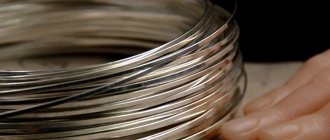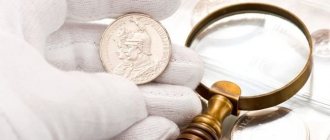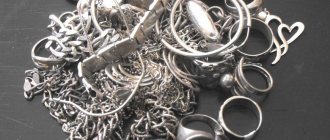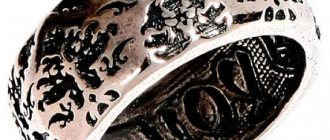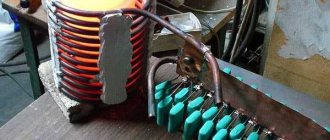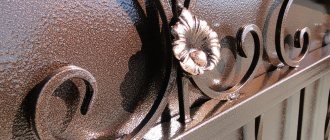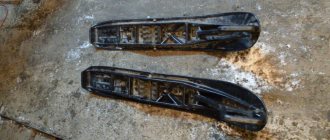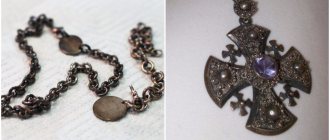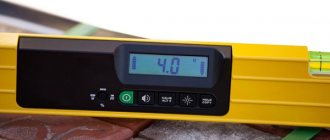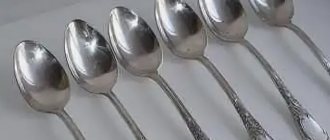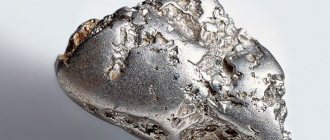Silver is one of the most popular metals used in jewelry and industry. To give the material strength and reduce its cost, various impurities are added to it. However, sometimes it is necessary, on the contrary, to remove excess from the composition and for this purpose silver refining is carried out. Purification technology requires the presence of certain ingredients and equipment, so it is carried out in special laboratories. But there are methods that can be done at home, thereby obtaining pure precious metal.
What is refining
Typically, the concept of “refining” means obtaining a metal of high purity through a series of procedures to remove impurities. This process is carried out in several stages, at each of which certain physical and chemical methods are used to separate interfering substances. Precious metals are often purified in this way.
The raw materials for refining in this case can be jewelry scrap, “silver foam”, sludge after electrical purification of the relevant substances and spot gold.
The subtleties of safe silver melting at home
Due to the chemical and physical properties of silver, the range of its use is very wide. The alloy can be used to create jewelry; it is included in radio components, circuit boards, microcircuits and other electronic elements. From them, as well as from jewelry scrap, a sufficient amount of material is obtained by melting for further use. Melting silver is not a complicated process if you understand the technology of its implementation, follow the sequence of actions and precautions.
How the path is chosen
For initially high-grade silver, electrolytic refining is used. Typically, when using this method, there is daily production. Electrolysis helps to obtain silver of exceptional purity due to redox reactions, in which impurities do not enter during purification.
In the case when argentum is in the form of a solution (insoluble sulfates and chlorides), the most economical and convenient way to deposit the metal is the chemical (in some situations, electrochemical) method.
Low-grade alloys are most often separated using cupellation - in this case, it is easiest to increase the purity of the mixture.
Process description
Before you start refining silver at home, you need to study in detail all the intricacies of the process and carry out various preparatory activities. This will help simplify the procedure for cleaning precious metal and complete it in a minimum amount of time.
To refine precious metal, you can use various objects that contain this material.
Among them, the most commonly used are:
- technical silver contained in transistors, relays and other radio components;
- old jewelry that is unsuitable for wearing;
- sludge from electrical cleaning of silver;
- silver foam, which is a waste product generated during the refining of lead.
The refining process is quite expensive, so its implementation should be approached with all responsibility. The first step is to decide on a method for purifying silver from impurities. This choice is made based on the following factors:
- amount of material available for cleaning;
- condition of the metal being processed;
- the need to ensure process continuity.
Cupellation method
This type of refining requires a furnace with a cup-like (assay) crucible. The purification process uses lead, the melt of which with silver is oxidized in the presence of oxygen. All impurities, including the solvent, are separated from the noble metal, giving it relative purity: gold and platinum family metals remain in the alloy.
To carry out refining, the furnace must be preheated. A technical lead-silver mixture is placed in it, which is heated until completely melted. Atmospheric air flows are launched into the oven, causing oxidation of the content components. Upon completion of the heat treatment, the crucible is removed and poured into molds.
The inside of the oven is lined with marl, a type of clay enriched with limestone and having a porous structure. It absorbs lead oxides formed during the refining process, since the latter are prone to evaporation when exposed to air currents. At the output, after oxidation of impurities, an alloy with a rainbow-iridescent surface is obtained. When it cracks, a bright silver sheen can be seen in the mixture, which indicates the completion of refining.
Cupellation is considered the roughest method of purification due to the fact that complete removal of impurities is not achieved: all noble metals in the alloy remain in place. Refining of gold, silver and platinum group metals for their separation is carried out by other methods.
Metal characteristics and melting point
Silver is more than 6,000 years old, as evidenced by archaeological finds in Turkey, Egypt and Iran. The second name of the precious metal is lunar, because according to esotericists, it is this luminary that serves as his patron, and the color resembles the cold shine of the Moon. In the past, this noble metal was valued more than gold.
Silver is characterized by the following physical properties:
- density - 10.6 g/cm3;
- hardness - soft and ductile;
- fusibility - high;
- thermal conductivity is the highest;
- electrical conductivity is the highest;
- reflectivity - yes.
The melting point of silver is 750-760 degrees.
Having decided to smelt silver yourself, you need to know the temperature at which the metal passes from a solid state of aggregation to a liquid state. It depends on the amount of foreign impurities in the composition. If the silver alloy includes a small amount of alloys, then its melting point will not exceed 750-760 degrees. The raw materials used in smelting are called charge. It is heated according to certain rules, taking into account the technological process, as well as observing safety precautions.
Electrolysis method
Electrolysis as a refining method is carried out with the consciousness of a double electronic layer: the anode of the process becomes a contaminated fragment of silver placed in a bag, the cathode is thin plates formed from non-corroding steel. The electrodes are immersed in a solution of nitrate of the metal being purified (ion concentration up to 50 mg/ml), nitric acid with a density of 1.5 g/l is added, and an electric current is passed.
Undissolved silver fragments, as well as contaminants, collect in the anode bags. A pure sample in microcrystalline form is collected in the cathode space. The volume of released silver may increase towards the other pole of the system, causing a short circuit. To prevent such a situation, the grown crystalline fragments, when stirring the solution, break off parallel to the electrodes near the cathode location. The resulting silver is recovered as sediment and subsequently cast into bars. It is important to replace the electrolyte on time, since if copper is present as an impurity, at the end of the desired process, its deposition on the cathode on top of the noble metal will begin.
If the silver solution behaves as a galvanic cell, the electrolytic method is also most effective for separating the metal. The anode can be graphite or non-corrosive (alloys), the cathode can be stainless steel. The voltage in the element is set at a level of no more than 2 V. The reaction itself is carried out until all the silver is deposited.
Work order
Actions to be taken:
- prepare a melting pot from a spoon;
- treat it with flux;
- heat the mixture until it transforms into a melt state.
To make a smelter, you need to cut 4 rectangles from an asbestos sheet. One should be larger than a spoon, the other should be its size, the next one should be half the size of the second, the last one should be even smaller. Wet asbestos rectangles with water until they soften. Place the smallest rectangle on the bottom of the melting spoon. Cover it with a larger plate on top. Place an even larger piece on it. Smooth each layer well with your fingers. The largest rectangle wraps the edges of the spoon completely around the perimeter along with the base of the handle. The entire structure is thoroughly crimped again. It turns out something like a shallow crucible. You can form a small groove at one edge to drain the molten metal.
The improvised smelter should dry well and harden.
Batch preparation. On an accurate scale you need to weigh out 20 g of scrap silver. Use a magnet to remove possible iron and steel particles.
Next comes the processing of the melting spoon with flux. Flux is needed to remove various oxides from the melt and to protect the melt from oxygen entering it. Borax is used as a flux. 1 part of flux is consumed for 10 parts of the charge of the same weight.
Place the dried spoon in a horizontal position and pour borax into it. Light the gas or gasoline burner and adjust the flame. It must be very soft so that the flux does not fly away in all directions. You need to heat the flux until it turns into a greenish honey-like mass. Open the air supply to the burner to make the flame harder and more powerful. Load a spoon with the mixture, putting 20 g of scrap silver in it. Heat the mixture until it turns red, melts and drips to the bottom of the spoon. Properly melted silver should shine. If its surface is covered with an oxide film (cloudy), then it has not yet melted.
Completely molten silver is like a small puddle of mercury. It can be poured into any form, preheated and lubricated with wax. The temperature of molten silver is about 950 degrees. The asbestos coating of the smelter can withstand 4-5 heats, then it will have to be changed. If melting fails, cool the ingot and repeat the whole process again.
Chemical refining
Silver can be extracted from solutions of salts or colloids using chemical technologies. The process is multi-stage. To carry out the procedure, sodium sulfite is required, when added, an exchange reaction occurs with the formation of a black precipitate of a new salt of the noble metal. Upon completion of the interaction, ammonia (ammonium chloride) or table salt is added to the resulting solution. The mixture is allowed to settle until there is a clear fractional separation - a cloudy and transparent part should form. Silver is considered to be completely deposited if the additional introduction of salts does not cause turbidity.
There are two ways to isolate pure metal from chloride - dry and wet.
Carbonate method for separating silver from chloride
This technology involves obtaining pure silver from dried chloride - the substance is combined with an equilibrium amount of sodium carbonate. In the crucible, the resulting mixture is heated (the bowl only needs to be filled halfway due to the increase in the volume of the contents due to the release of gas). After the formation of volatile products is complete, the process temperature increases, reaching the values necessary for smooth melting.
After the system has cooled, the silver is removed and re-smelted, after which the product can be considered ready. A negative point may be the fact that technical soda has a negative effect on the condition of the crucible. The main advantage of this method of chemical refining is its speed.
Where is silver found?
The main source of technical silver is radio equipment and electrical industrial equipment of Soviet production.
You need a considerable number of “silver plated” contacts, which
can be extracted from the following devices, radio components and devices that have expired:
- mine magnetic starters;
- mine substations;
- relay;
- temperature sensors;
- communication equipment;
- electrical computer equipment of modern and ancient production.
Reductive method for separating silver from chloride
To restore silver from solution, you can take different sets of reagents - sulfuric acid with zinc or iron, or hydrochloric acid with the same metals, including aluminum.
One of the elements is introduced into the chloride medium. The selected acid with a concentration of 0.2 parts by mass is added to the resulting sludge. You can add the solution in parts, monitoring the degree of progress of the reaction and adding the remainder when it is completed. A qualitative sign of interaction in this case is the release of hydrogen - gas ceases to form at the moment of complete dissolution of the metal or disappearance of the acid (its consumption can be certified by indicator paper).
The separation of silver from salt is completed when the system becomes similar in color to lead. After this, acid is added to bring the remaining fragments of unnecessary metals into solution (large parts are manually removed). The remaining powder substance (the so-called silver cement) is cleaned with distilled water, dried and melted.
Chlorine refining
The method is based on the assumption that silver and base metals react faster than gold and the platinum family of elements in a chlorine atmosphere. This makes it possible to separate the latter substances from the substance being purified (in refining technology, the most labor-intensive process is the separation of noble alloys).
The molten rough gold is passed through chlorine gas. The interaction begins with non-noble impurity elements, then silver passes into the form of the compound, which can subsequently be isolated by other refining methods. Chlorides in the mixture float to the surface due to the lower density of salts compared to metals.
Necessary materials, tools and equipment
The following materials are required for refining:
Tools used for refining:
- Glass container.
- Glass rod.
- Copper bar or tube.
- Flanges, round nose pliers, wire cutters and awl.
- Fabric bags.
Equipment for different methods of silver refining:
- Bake.
- Cup-shaped crucible.
- Transformer (power supply).
- Burner.
- Special cells made of sandstone or plastic.
- Special dishes.
Refining in other cases
If there is a copper impurity in silver, it is rational to speak not of an alloy, but of a mixture of metals (can be presented in the form of shavings). Then the base metal can be dissolved with nitric and sulfuric acids. Concentrated substances are used cold or hot (the speed of the reaction depends on this).
To remove the silver shell from products, the mixture is heated over an alcohol lamp or in a water bath. At temperatures below 50-60 degrees, you can use glass or porcelain dishes. In the same way, you can separate the metal being purified from nickel, tin or lead.
Melting silver at home
Melting silver is quite possible even without special knowledge and skills. The only condition is the presence of a suitable burner or stove. The equipment must meet the required parameters and be heated to a temperature suitable for these purposes.
Equipment and materials
When deciding to smelt silver, you need to make sure you have the necessary tools and materials. To work you will need:
- silver scrap;
- burner;
- fireproof container (crucible);
- casting mold;
- borax;
- forceps;
- metal container with cold water.
Dissolution with nitric acid
Silver nitrate is prepared immediately for the entire process - usually 50 grams of metal per liter of solvent is taken (to obtain this ratio, 32 g of scrap is dissolved in 80 g of hydrogenated nitric oxide V). The acid must be diluted in equal proportions with water and mixed with a glass rod. It is possible to refining silver with nitrate by mixing ammonium nitrate with an electrolyte (with a reaction of the medium less than 7) to obtain the same HNO3. Pieces of silver are added to the resulting solution. The mixture must be left for 10-11 hours, since the transition of the metal into a suspended state will not occur immediately. Violent release of red-brown gas is possible. If the solution acquires bluish or greenish tints, this indicates the presence of vitriol or iron impurities. Refining silver with nitric acid works better in cases where there is no intense coloration.
contents .. 11 12 ..GOLD AND SILVER CLEANING MELTING
If gold and silver are fragile, then this indicates that they contain harmful impurities, such as sulfur, antimony, tin, zinc, etc. In such cases, it is necessary to purify the gold or silver, which is done in different ways.
1. Melting with saltpeter
The ingot to be cleaned is melted in a crucible with saltpeter, borax and potash (instead of potash you can also use soda); The molten mass must be stirred well so that the saltpeter acts evenly on all metal particles. At first the mass is very agitated, as if boiling, but then, when the effect of the saltpeter ends, the mass calms down and then the crucible is removed from the furnace. The effect of nitrate is that it oxidizes base metals, such as zinc, tin, copper and others; potash and borax dissolve the resulting metal oxides, resulting in liquid slag. In this way, gold and silver are purified not only from tin and zinc, but also partly from copper. The contents of the crucible are not poured into the mold, but the crucible is allowed to cool, after which it is broken, and at the bottom there will be an ingot of gold and silver, and above it a fragile slag, which is easily separated by blows of a hammer. The amount of fluxes, i.e., saltpeter, potash and borax, required to purify gold and silver, varies depending on the amount of impurities in the latter: the more impurities, the more fluxes will be required. Potash and borax should be taken in excess, since if there is a shortage of them, metal oxides form a thick mass that cannot be separated from gold and silver. If not enough fluxes were taken, then the resulting ingot may again become brittle and then it will have to be melted again with fluxes. Craftsmen purify small amounts of gold and silver by melting them on clay with saltpeter. They do it this way: they take a piece of lime coal, cut a hole in it, cover it with clay and dry it, then put gold and borax on the clay and melt it using a blowpipe. When the gold melts, add saltpeter to it and melt it well with it. Such blowing on clay sometimes needs to be done several times until you get malleable gold.
2. Smelting with lead
Place the gold or silver ingot to be cleaned in a crucible, pour a little borax on top and place the crucible in a hot forge. When the ingot is melted, lead is placed in the crucible (in the form of grains, strips or small pieces), after which the metal is mixed well and cast into a flat mold. In this way, an alloy with lead, the so-called “werkblei”, is obtained, which is then subjected to purification smelting in special bowls made of bone ash. These bowls are not difficult to prepare yourself: the bones are burned in a forge; well-burnt bones are pounded in a mortar into a fine powder and sifted through a hair sieve; the resulting bone ash is moistened with water so that, when squeezed in the hand, it does not loosen, and then it is stuffed into an iron cup or a round iron box (without a lid) to the top and compacted tightly; then cut a hole in the heel and dry it well. Instead of bone ash, you can use wood ash, which is sifted through a fine sieve and then leached with hot water in a cast-iron cauldron (changing the water several times). Sometimes bone ash is mixed with wood ash in equal parts. Cleaning smelting can be done either in a self-blowing forge with a side hole, or in a forge, and a clay muffle* is inserted into them, which is then lined with coal on all sides, with the exception of one front. But it is more convenient to melt in a muffle furnace.
_________________________________________ *The muffle is not placed directly on the grate or on the hearth, but on stands made of refractory bricks.
To give an idea of the structure of a muffle furnace, we present it in Table. I fig. 4 and 5 are images of it in two sections. The muffle m rests with its front end on the ledge of the front wall of the furnace, and with its rear end on three clay pads that lie on the threshold n. The bricks on which the muffle is laid are coated with a mixture of clay and bone ash so that the bottom of the muffle does not stick to them; P - working hole in the outer wall of the furnace; it closes or opens, depending on need, either with an iron shutter or with bricks. The combustion is carried out through the T hole; K - cast iron grates; 3 - ash pan; D - chimney. The air draft is controlled by a damper in the chimney and doors in the ash pit. In small furnaces, a muffle made of refractory clay is used; in larger ones they are laid out from refractory bricks. The described device of a muffle furnace also applies to the case when flaming coal is used for the firebox; for coke and charcoal, the furnaces must be arranged so that fuel can be poured from above onto the muffle. Now we move on to the description of the purification smelting. After the forge or muffle furnace is hot, open the working hole and bring a bowl with a bone heel into the muffle. When the bowl is hot, put a wereble in it and set the heat to high, closing the window of the forge. After the werkblei is melted, the window is opened and the melting is observed. In this case, the following phenomena occur: werkbley lead is oxidized by air into lead oxide - “littlet”; lithargic oxidizes base metals: tin, zinc, copper and others; the oxides of these metals dissolve in excess litharge and form partly a low-melting slag, which is absorbed by the porous walls of the heel, and partly a low-melting crust, which collects on the surface of the molten metal. The crust of refractory oxides (zinc and tin) must be removed with an iron spoon, since otherwise they can cover the entire surface of the molten metal and stop air access to the latter; if there are few such oxides, then they limit themselves only to raking them with an iron spatula or a hook to the edge. The crust removed from the werkbley should not be thrown away, because it may contain a small amount of gold and silver; Usually it is placed in gold dust or grains, collected in every workshop. During the entire melting of the werkbley, litharge is formed, which, as we have already said, contributes to the oxidation of various metals and is partly absorbed with them by the walls of the bone heel, and partly evaporates in the form of vapors. So as the melting proceeds, the amount of werkble gradually decreases and finally a shiny surface of pure gold and silver appears. After this, the bowl is removed from the muffle, the metal is allowed to cool and it is knocked out of bone ash impregnated with slag. When cleaning the werkbley, you must keep in mind the following circumstances: if the amount of werkbley is large, so that it cannot be accommodated by a nest made in a bone heel, then cut off the appropriate amount from it, namely: by weight, no more than twice the weight of the heel ; if too much werkbley is taken, it may happen that the heel is completely saturated with slag before the cleaning is completed. Let’s assume that the weight of the heel is 1 pound, then about 2 pounds of werkbley can be cleaned on it, and this is the amount of it that is weighed. Then they look at the size of the nest in the heel, whether 2 pounds of molten werkbley can fit in it; if the nest is of sufficient size, then a weighed amount of werkley is placed immediately; if the nest is small, then separate as much as can fit in it, weigh it (let's say 1/2 pound) and melt only this amount, and then during the melting, when space is free in the nest, add a little fresh werkbley until all 2 lbs have come out. If there is not enough lead in the werkbley, then the cleaning will not be completed; in this case, the separation of litharge vapors will stop, and the surface of the metal will remain dark. To complete the cleaning, you will have to remove the bowl from the muffle and knock out the metal from the bone heel; fill the bowl with fresh heel and continue cleaning on the last one: put metal in it and add a new amount of lead (let's say 1 pound); set a strong heat, closing the forge, and when the metal and lead are melted, open the window of the forge and watch the melting. If enough lead has been added, then the purification will be completed and pure gold and silver will be obtained. To process all the werkbley (let's say there are 8 pounds of it left), two pounds would have to be separated again, the bone heel prepared again, and the cleaning done as before. If it turns out during the first cleaning that the werkbley contains an insufficient amount of lead, so that it was necessary to add it as described above, then it is better to melt the remaining werkbley (i.e. 8 pounds) in a crucible with a new amount of lead. Since for 2 pounds of werkble it was necessary to add 1 pound of lead, then for 8 pounds it will be necessary to add another 4 pounds. Melting it in a crucible, we get 12 pounds of werkbley, which contains lead in sufficient quantity for purification. Separating 2 pounds each time, we process the entire amount of werkbley into six melts. Let us also note that when melting werkbley, it is necessary to ensure that the heat in the forge is sufficient, since otherwise the metal may solidify and then it will be difficult to melt it again. If the heat is sufficient, the litharge vapors quickly separate upward from the metal surface; if the heat is weak, then the vapor spreads over the molten metal. Instead of alloying gold with lead in a separate crucible, this alloying can be done directly on a bone bowl, i.e., weighed amounts of gold and lead are placed in the bowl (the latter must be heated in a muffle), the working opening of the muffle furnace is closed with a damper and set high fever; after some time, when the gold and lead have melted, open the damper and continue the purification smelting, as described above. Cleaning with lead is quite painstaking work, but it is possible to obtain pure gold and silver; if there was no silver in the ingot being purified, then only pure gold is obtained. Using the described method, you can determine the sample of an ingot containing gold or silver (fire test). To do this, you need to weigh out 1 spool of shavings or small pieces from the ingot (the shavings are obtained by scraping, and the pieces by knocking out with a chisel) and clean them by melting with lead on a bone bowl; after this you will get a grain or, as they say, a “kinglet” of pure metal. If the bead is yellow, this will indicate that our ingot contains a lot of gold; if the king is white, then this means that the ingot either has no gold at all, or there is little of it, and there is a lot of silver. If it happened that after cleaning there was no bead left on the bone bowl, then this would mean that the ingot contains neither gold nor silver, but only base metals: copper, zinc, tin and others; finally, if instead of a shiny bead on the bowl there was a dark gray burnt piece, then this would indicate that the ingot contained some kind of difficult-to-melt metal: iron, nickel or platinum. Looks like we got a wren; this beetle must be removed from the bowl with pliers, its lower surface must be cleaned from bone ash with a wire brush and then weighed; let its weight be 60 shares. Then the kinglet must be fused on charcoal (using a blowpipe) with triple the weight of pure silver*, i.e. the latter should be 180 shares of 1 gold. 84 shares, then we get an ingot weighing 2 gold. 48 shares; this ingot must be flared into a thin plate, rolled into a tube and then placed in a porcelain cup or flask, into which chemically pure nitric acid of medium strength is poured (about 24′ according to a Baume hydrometer)**.
_____________________________________________________ * Melting the bead with silver is required due to the fact that nitric acid completely etches silver only from such alloys in which there are 3 or more parts of silver per 1 part of gold; with a lower silver content, nitric acid dissolves only part of it, while the other part remains in the gold mass. ** Strong nitric acid (for example, 30 Baume) boils in bursts when heated; To make the boiling calmer, you need to throw a small piece of charcoal into the acid.
To accelerate the action of nitric acid, it must be heated, and the silver will dissolve. If enough acid was taken, then after some time (let’s say, after two hours) all the silver will dissolve and only pure gold will remain in the flask, and if the plate is strongly corroded by the acid, then the gold will turn out in the form of a brown powder, otherwise it will turn out in the form of a tube. After this, the acid is poured away, the gold is washed several times with distilled water, then it is transferred to a porcelain crucible, dried in the latter and weighed. Let's assume that the weight of the gold received is 32 shares; therefore, our bar contains 32-carat gold; subtracting 32 from 60 slices, i.e. from the weight of the king, which was obtained after cleaning with lead, we find that the ingot, in addition, contains 60-32 = 28 samples of silver. If, when welded in nitric acid, the metal plate dissolved without a residue, this would indicate that the ingot contains no gold at all, and contains 60 samples of silver*.
2. Melting with antimony (antimony sulphide)
To obtain high-grade gold from low-grade gold, craftsmen sometimes use smelting with antimony; and they do this: take 1 part gold to 3 parts antimony, melt them on coal using a blowpipe and cast them into a conical socket made in stone, or into an iron mold shaped like a shot glass (the socket or mold must be oiled before casting) ; in this case, the gold will settle to the bottom, and antimony will gather above it; knock the ingot out of the mold, beat the antimony from the gold and then blow it again on coal with a blowpipe to drive out the antimony remaining in it; When blown, the latter burns out and evaporates in the form of smoke, and purified gold remains on the coal. To obtain pure gold, it is usually necessary to repeat the melting with antimony two or three times. Although this method is used by craftsmen, it cannot be recommended, because in this case there is a significant loss (waste) of gold.
*In the Assay Offices, a special (assay) balance is used to determine samples, consisting of an assay pound and the division of the latter into spools; an assay pound is 6 parts of civil weight. For testing, take shavings or a piece of metal in the amount of 1 assay pound. Very sensitive scales (chemical) are used for weighing.
contents .. 11 12 ..
Filtration
A funnel and filter paper are used to separate the metal from the solution. The solution and cement are poured into a specially prepared container: the copper salt flows through a layer of parchment, and the silver remains on the surface. Subsequently, it is necessary to rinse the filtrate another 5 times with distilled water.
There is likely to be some remaining silver in the solution. To extract it, table salt is added to copper until a curdled sediment forms.
Silver cement is dried. Melting is carried out in a crucible, the use of which is not intended for working with purer samples. The sample must be heated evenly to avoid flying silver or oxidized dust. You can add baking soda and borax, mixed in equal proportions, to the surface of the melt - the composition will create a glassy film over the metal that protects against loss.
The resulting substance is of low quality. To clean it more thoroughly, electrolysis of silver is required. Refining in this case is carried out according to the method already described above - for this it is convenient to melt the metal into granules.
Methods for removing impurities
Nowadays, you can buy chemical reagents on the open market, so refining silver-plated contacts at home will not be difficult .
It is necessary to follow safety precautions and use respiratory, eye and hand protection.
Carry out reactions with good air exchange, with a hood, or even better - outside. When fusing the resulting metal, observe fire safety.
Refining with electrolyte and ammonium nitrate
The method is suitable for those who cannot purchase and use nitric acid.
The meaning of this reaction is the interaction of ammonium nitrate and sulfuric acid located in the electrolyte with increasing temperature . As a result of heating, a stable compound of nitric acid is obtained, which dissolves the technical silver alloy.
To carry out the reaction you will need:
- chemical resistant glassware;
- sulfuric acid based electrolyte;
- ammonium nitrate;
- electric stove;
- sand bath;
- zinc shavings to highlight metallized silver;
- salt;
- hydrochloric acid;
- hot water.
To successfully carry out the chemical reaction of dissolving 100 g of technical silver, 2 parts of electrolyte (1 liter), 1 part of ammonium nitrate (0.5 kg) are used. The dissolution process takes about 24 hours.
Procedure:
- a glass container (three-liter bottle) is placed in a sand bath heated by an electric stove;
- the recyclable material and reagents are poured into the container: 150 g of saltpeter, 300 ml of electrolyte;
- with increasing temperature, a reaction occurs, boiling is visually observed , the release of a reddish gas, a change in the color of the liquid (a blue tint appears);
- when the dissolution process subsides, chemical components are added in the selected proportion;
- after complete dissolution of the immersed metal, warm water and table salt are used to obtain silver chloride;
- the bottle is filled with H2O almost to the neck, after which salt is added, the amount of which is determined by the end of the precipitation of chloride flakes;
- filtration is performed to separate the silver chloride from the liquid;
- in the same glass container, the resulting white filtered material is poured with hydrochloric acid, the height of the coating is 2 cm above the sediment;
- zinc shavings are poured into the prepared solution, which reacts with HCl and displaces metallized silver, the reaction is accompanied by the release of hydrogen;
- since the gas is explosive, it is necessary to take precautions : ventilation, absence of sources of fire and heating;
- after 20 - 30 minutes an earth-colored precipitate is obtained - this is Ag;
- should be checked for the presence of acid in the solution: it is necessary to dip the Zn shavings into the liquid using tweezers, as a result a dissolution reaction should occur;
- if there is no interaction , then it is necessary to add HCl to the container to remove zinc from metallized silver, so that during alloying you do not get a brittle metal that is not suitable for use;
- the precipitate is washed and fused in a crucible using a gasoline or gas burner.
Use of nitric acid
The process of separating pure silver from a technical alloy using nitric and sulfuric acid is not particularly complicated.
For 100 g of processed material, 200-300 ml of each reagent will be required.
The following devices and materials are used :
- acids in the required quantity, based on the weight of the proposed material;
- table salt to obtain silver chloride;
- zinc in the form of chips or powder;
- glass chemical containers;
- electric stove;
- sand bath;
- soda;
- filter paper, watering can;
- tools for melting the resulting metal.
- The prepared alloy is placed in a vessel filled with nitric acid. Next, a dissolution reaction occurs with a large release of heat and acrid red smoke. You should follow safety rules, use ventilation, protect your respiratory system and eyes. Dissolution occurs faster with additional heating.
- The resulting solution is diluted with warm water: for 0.5 liters of metal dissolved in acid, about 2 liters of H2O are added.
- Table salt is added to separate the silver chloride. When choosing the required quantity, they are guided by the principle “you can’t spoil porridge with oil.”
- The resulting precipitate is filtered and washed with water .
- After which it is dissolved with sulfuric acid in a vessel for evaporation.
- The process of crystallization of metallic silver occurs by adding zinc powder to a solution of H2SO4 and heating it in a sand bath.
- The resulting substance is washed with soda dissolved in water and fused in a crucible using a burner.
Safety precautions
It is important that the room has good ventilation. For protection, it is recommended to use gloves, a gown and protective glasses. To avoid acid splashing, the concentrate itself is added to the water, and not vice versa. Obtaining HNO3 by exchange reaction is the safest method by which silver can be refined. In this case, ammonium nitrate is mixed with an electrolyte (the reaction of the medium is less than 7). Chemical glassware should be tested for temperature resistance, since the heat of the process can exceed 100 degrees. No more than a third of the vessel is filled with the solution to avoid splashing of the acid.
Mistakes when refining silver
- Excessive amounts of nitric acid will lead to a bad reaction, the release of nitric oxide (“red tail”) in particular.
- The vertical arrangement of the electrodes one above the other when refining silver by electrolysis significantly weakens the effect of the electrolyte, and the silver is separated very slowly.
- During electrolysis, excess current can produce silver oxide, causing the precious metal to turn black.
- A fatal mistake is failure to follow safety rules when refining silver by any method. Inhalation of toxic chemical fumes, burns, etc. will not please the silver miner.
